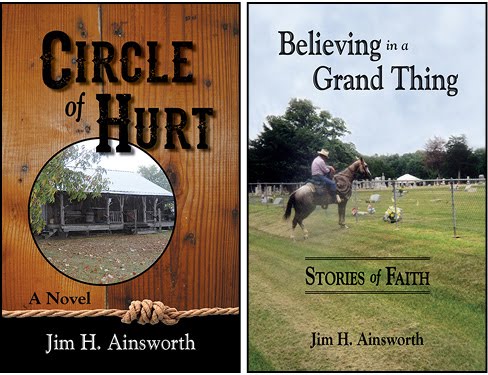When I took a
sabbatical from the financial services field, I never imagined that it would be
permanent. Walking away from knowledge and skills I had spent most of my adult
life accumulating and honing seemed, well, dumb, even incomprehensible.
But my list of things to do before I die included a few
things that I might be too old to do before long. So I rationalized my sabbatical as a chance to check off a
few things on that list while I still had the physical stamina and desire to do
them. I’m glad I checked them off, because I don’t think I have the energy now.
Shortly after I
extricated myself from most of the entanglements of my profession, I got a call
at home one night from cousin Shep challenging me to retrace our grandparents’
and parents’ journey across Texas in a covered wagon in 1918. To his surprise, I
accepted.
That trip changed my
life for the better. I chronicled that trip in Biscuits
Across the Brazos.
It gave me the
confidence to pursue a few other dreams that were starting to look a little
less plausible. After that, anything seemed possible.
I have posted here about
my horse packing trip in Wyoming (taken while I still had to go to work every
day). You can see that a lot of my dreams had to do with fulfilling the cowboy
life I had imagined for myself as a boy, but had put aside to make a living and support a family.
With newfound
freedom, it was not unusual for me to choose a dream one day and leave to
fulfill it the next. In other words, I was having the time of my life. On a
whim, I drove to Alpine for the Cowboy Poetry Gathering in cold
February. One day, I will write about the morning legendary author and story-teller Paul
Patterson brushed away snow on a bench at a chuckwagon breakfast and
sat down beside me.
Paul told me that he
was a good friend of Elmer Kelton’s and that Kelton
had illustrated and written the foreword to one of Paul’s books. At that time, Kelton
was the most prolific and beloved writer of westerns alive, but I had not known
that he was also a talented artist. Friend
Robbie Plunkett is a big fan of Patterson’s books.
Before leaving the
Big Bend area, I dropped in on Ft. Davis, Marfa, Marathon and the Gage Motel,
and Terlingua, home of the Chili Cook off. I still marvel at the carefree
freedom I felt as neither distance nor obstacles seemed to matter. I was hungry
for different experiences after being tied to schedules, desks and telephones
for thirty years.
I became a regular
at the Abilene Western Heritage Classic. I enjoyed sitting alone in the stands for
hours watching ranch cowboys show their ranch horses. I marveled not only at their
horsemanship, but their style, the tall-topped boots, big spurs, colorful wild
rags, and big hats.
Always a lover of
tack, I relished watching what they put on their horses’ backs and heads and in
their mouths. I was fascinated by romel reins, bosals, mecates, and the little
grass ropes that the cowboys tucked under their belts. I was intrigued by the
pull harnesses that replaced breast harnesses. Many years earlier, my
fascination with tack and love for good boots had inspired me to open a western
wear store called Chute I.
On my second trip to
the Abilene Classic, I was sitting in the stands watching ranch team roping
when I heard a deep voice holler, “Yeah!” as a roping team made a clean run
with two feet caught. The voice seemed like an echo from my past. I looked
around for the source, but could not find him.
As the competition
drew to a close and the winning team was announced, I heard the voice again. It
was a distinctive voice, one I knew I had heard before, but I just could not
place it. It came from a mouth that seemed to be full of something like bubble
gum or chewing tobacco. A throaty, bass
sound, almost slurred.
On the third cheer,
I saw a large man stand with a clenched fist, a sign of approval for the ranch
team in the arena. He wore a hat that matched his size. When he walked past me,
the large hat kept his face shadowed, but I knew who he was.
The voice was older,
mellower, like it was emerging from the long, dark, tunnel of my past and just
waking up from a long sleep. I followed him and another cowboy out of the
arena, waiting for a break in a conversation that seemed very serious, but they
entered a room open only to ranch rodeo contestants before I could approach.
I waited almost an
hour for him to reappear, still engaged in deep conversation with the same
cowboy. I followed behind them, enjoying myself, taking time to observe
everything he wore from the tall riding heels on his boots, the large spur
rowels, and the huge palm leaf hat, looking for a sign of the seventy-pounds-lighter
boy I once knew.
Finally, the other cowboy peeled off and I
stepped beside my old friend, matching him stride for stride, looking straight
ahead. He glanced in my direction, nodded and kept walking.
For a second, I
thought I had made a mistake. I had not seen him or spoken to him in almost
forty years. But no, this had to be Calvin.
I purposely bumped
him enough to take him off stride. He turned again. I smiled and he put out his
hand. “Well, damn, Jimmy Ainsworth, you got old, didn’t you?”
“Tried to stop it,
but it just took hold.”
He patted his stomach. “Guess I’ve changed a little myself.”
“You have, but I
recognized your voice.”
We talked a few
minutes, trying to cover forty years, recalling raucous tales from our teen
years, but he had a team of ranch cowboys and stock to look after and had to prepare
for the ranch rodeo that night. He introduced me to his ranch hands from the
Quien Sabe Ranch. I watched as they tended their horses and checked their tack
for the events that night.
Calvin had been
ranch manager at Quien Sabe for more than twenty years. I was surprised. I had
always thought of my old friend as a wheat and milo farmer. But when I thought
back, he had a black horse he called “Old Stud” and hired out to do daywork as
a cowboy when his family could spare him from the farm.
I watched his team
compete that night and saw how the years had made him into a genuine ranch
cowboy, an occupation I had aspired to during our years of roaming the
Panhandle countryside and playing sports together. I thought I could best him
team roping, but he had me beat in all the other events. He had both horse
sense and cattle sense, and was clearly the leader of the team in that arena.
The other cowboys, mostly younger, obviously looked up to him.
About two years after
meeting Calvin in Abilene, I completed the first draft of my first novel. I had
read a lot of books about writing and decided to attend my first writers’
conference and try to connect with real authors. My expectations were low, but
I hoped to discover if what I had written was anything close to worthwhile. I
chose Amarillo because I wanted to see the Quien Sabe and my old home place. I
would be a trip I would never forget.


